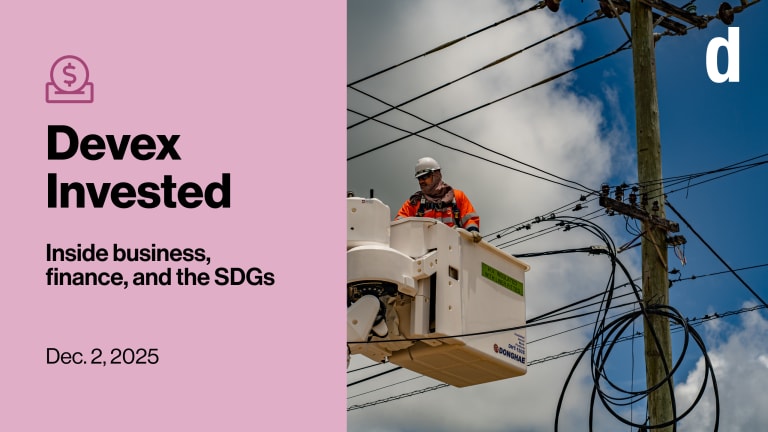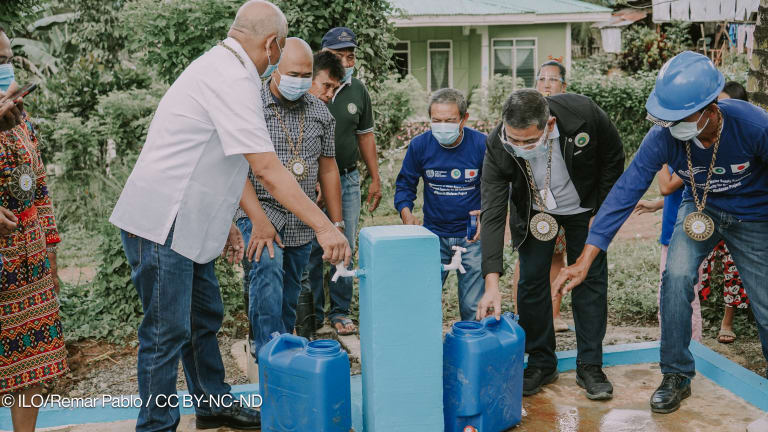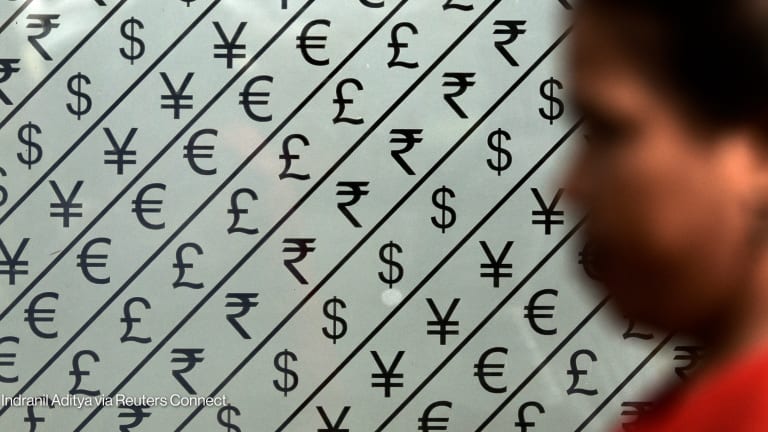Interactive: Identify future ADB funding
The Asian Development Bank's country operation business plans are critical to the bank's funding. Devex breaks down the COBPs into yearly data to identify which countries and sectors ADB plans to invest in and where things are changing.
To follow Asian Development Bank funding, you first need to familiarize yourself with its country operations business plans. If you’re already familiar with COBPs, you can skip forward to the “Pipeline Summary” section to see an overview of the latest documents. If you want to learn more about the COBPs first, keep reading. ADB releases annual COBPs to map out its business strategy over the next three years in each of the 37 countries where the bank operates. These documents describe the cooperation strategy between ADB and the member country and include a pipeline of grants and loans of projects to be implemented there. Organizations interested in sourcing ADB funding use the COBP to identify future funding opportunities by sector and country, the amounts provided are the total estimated requirements of each project. The bulk of this funding generally comes from the bank's lending windows, while a lesser amount is disbursed through grants and technical assistance contracts. ADB provides part of the money required, but the bank expects a portion of a project’s total to be provided by third-party financiers. In most cases, this is the borrowing government, but there are instances when part of the project is financed by other funders, for example, the Japan Fund for Poverty Reduction or a bilateral donor such as the Australian Department of Foreign Affairs and Trade or the U.K. Department for International Development. <div class='tableauPlaceholder' id='viz1632867874850' style='position: relative'><noscript><a href='#'><img alt='Home ' src='https://public.tableau.com/static/images/As/AsianDevelopmentBankProjectPipeline/Home/1_rss.png' style='border: none' /></a></noscript><object class='tableauViz' style='display:none;'><param name='host_url' value='https%3A%2F%2Fpublic.tableau.com%2F' /> <param name='embed_code_version' value='3' /> <param name='site_root' value='' /><param name='name' value='AsianDevelopmentBankProjectPipeline/Home' /><param name='tabs' value='no' /><param name='toolbar' value='no' /><param name='static_image' value='https://public.tableau.com/static/images/As/AsianDevelopmentBankProjectPipeline/Home/1.png' /> <param name='animate_transition' value='yes' /><param name='display_static_image' value='yes' /><param name='display_spinner' value='yes' /><param name='display_overlay' value='yes' /><param name='display_count' value='yes' /></object></div> <script type='text/javascript'> var divElement = document.getElementById('viz1632867874850'); var vizElement = divElement.getElementsByTagName('object')[0]; if ( divElement.offsetWidth > 800 ) { vizElement.style.width='600px';vizElement.style.height='1100px';} else if ( divElement.offsetWidth > 500 ) { vizElement.style.width='600px';vizElement.style.height='1100px';} else { vizElement.style.width='100%';vizElement.style.height='1150px';} var scriptElement = document.createElement('script'); scriptElement.src = 'https://public.tableau.com/javascripts/api/viz_v1.js'; vizElement.parentNode.insertBefore(scriptElement, vizElement); </script> How can Devex help you understand the COBPs? Devex analyzes the data released each year to identify which countries and sectors ADB plans to invest in, when it is planning to make those investments, and how the institution’s priorities are changing. The funding forecasted in the COBPs published in 2018 and 2019 was worth over $115 billion, with transport, energy, and water sectors receiving the most funding. Once Devex extracts the information from published COBPs, it is easily accessible through the interactive data visualization. This visual format allows Devex Pro Funding members to quickly identify opportunities of interest in the pipeline, as well as the context — such as which third-party funders to connect with and when to engage — to plan an efficient business development strategy. The interactive is a go-to source throughout the year for ADB’s planned procurement. The content is searchable and filterable in our funding search — each project is stored as a “funding activity” entry, the report type for early-stage information about funding opportunities. Click to view the latest ADB COBPs in the funding search. What is the next step to source funding? The COBPs give estimated procurement dates for each project, although the time each project takes to move through the pipeline varies. Once funding of interest has been identified in the COBPs, ADB procurement plans generally provide more detail of upcoming projects within particular countries. ADB then releases a program report outlining project scope, disbursement amount, and different project components. Often, organizations develop a 12-month strategy for engaging ADB projects. Those interested in partnering should be involved at the earliest stage possible, which means connecting with the ADB project contact — mentioned within the COBP PDF on the ADB website — and other interested partner organizations. Organizations and consortiums that have been shortlisted and awarded ADB contracts in the past are accessible on Devex’s funding search. The final step in sourcing funding is responding to the request for proposal at the tender or grant stage. Individual COBPs are released over time, rather than all at once. Generally, the bank begins to publish COBPs toward the end of the calendar year, with some showing up as late as the middle of the following year. Devex aggregates the COBP data as soon as ADB releases the documents. Keep reading for our analysis of the latest COBPs. Pipeline summary for 2021-2023 In 2020, the COBPs for fiscal year 2021-2023 published by ADB included 1,375 projects for 24 countries. The total budget, aggregating all the projects in the pipeline, is $221.4 billion— $127.7 billion from the bank itself and $93.7 billion from other donors. The biggest chunk of projects and funding is for South Asia at $103 billion for 888 projects, or 64.6% of all projects, followed by Central Asia at $18.2 billion for 368 projects, or 26.8% of all projects, and East Asia and Pacific at $6.5 billion for 119 projects, or 8.7% of all projects. By country, India is the most funded at $30.5 billion for 168 projects, followed by the Philippines at $18 billion for 85 projects and Bangladesh at $15.4 billion for 133 projects. But smaller countries also feature — for example, Bhutan is set to receive $482.3 million for 36 projects, Armenia has $298.5 million for 26 projects, and the Maldives gets $278.9 million for 23 projects. Meanwhile, the South Commuter Railway Project in the Philippines got the largest allocation from the bank at $1.75 billion, complemented by a $1.67 billion contribution from the Japan International Cooperation Agency. By sector, transport was the bank’s top priority with an allocation of $38.4 billion for 238 projects. Investing in national rail systems, institutions, and operations, together with urban transport, are areas of growing importance in 2021 and 2022. The incorporation of emerging technologies, such as e-vehicles, and the use of data for operators and users will also be a priority in ADB transport projects. Next was energy at $14.8 billion for 164 projects; agriculture, natural resources, and rural development at $13.3 billion for 185 projects; finance at $11.7 billion for 123 projects; and public sector management at $9.5 billion for 160 projects. The pipeline of projects included in the COBPs for 2021-2023 also includes 67 COVID-19 projects worth $47.3 billion, with $13.3 billion from ADB and $34.1 billion from other donors. The Philippines is the most funded at $2.1 billion for 8 projects, followed by India at $2 billion for 3 projects and Bangladesh at $1.9 billion for 9 projects. The COVID-19 Active Response and Expenditure Support Programs in India, Indonesia, the Philippines, and Thailand are the most funded programs, with $1.5 billion each in funding from ADB. Jan. 21, 2021: This article has been updated with analysis of the latest COBP documents. Explore the data in our Tableau interactive of ADB’s Country Operation Business Plans showing the where, when, what, who, and how of ADB investment.
To follow Asian Development Bank funding, you first need to familiarize yourself with its country operations business plans.
If you’re already familiar with COBPs, you can skip forward to the “Pipeline Summary” section to see an overview of the latest documents. If you want to learn more about the COBPs first, keep reading.
ADB releases annual COBPs to map out its business strategy over the next three years in each of the 37 countries where the bank operates. These documents describe the cooperation strategy between ADB and the member country and include a pipeline of grants and loans of projects to be implemented there.
This story is forDevex Promembers
Unlock this story now with a 15-day free trial of Devex Pro.
With a Devex Pro subscription you'll get access to deeper analysis and exclusive insights from our reporters and analysts.
Start my free trialRequest a group subscription Printing articles to share with others is a breach of our terms and conditions and copyright policy. Please use the sharing options on the left side of the article. Devex Pro members may share up to 10 articles per month using the Pro share tool ( ).
Claire Mc Govern is the Lead for Devex's funding platform analysis based in Barcelona. She has previously worked in public relations in Dublin and research on migration for the United Nations University Institute on Globalization, Culture and Mobility in Barcelona. She holds a masters in International Relations from the Institut Barcelona d’Estudis Internacionals, and a bachelor of arts in Multimedia from Cork Institute of Technology.
Miguel Tamonan is a Senior Development Analyst at Devex, where he analyzes data from public and private donors to produce content and special reports for Pro and Pro Funding readers. He has a bachelor’s degree in Political Science with a Major in International Relations from the Polytechnic University of the Philippines.









